GE GDF645SMNES, PDT785SYNFS, PDT715SMNES, PDT715SFNDS, PDT775SYNFS Use & Care Guide
...
<![endif]>DISHWASHERS
|
SAFETY INFORMATION |
4 |
|
|
|
||
|
OWNER’S MANUAL |
||
|
|
|
|
|
USING THE DISHWASHER |
|
GDF 565-645 Series |
|
Getting Started |
6 |
|
|
GDT 565-665 Series |
||
|
Dispensers |
10 |
|
|
GDP645 Series |
||
|
Appliance Communications . . . . . . . . . . . . |
12 |
|
|
Loading . . . . . . . . . . . . . . . . . . . . . . . . . . . . . |
13 |
DDT700 Series |
|
CARE AND CLEANING |
20 |
PDT715-785 Series |
|
PDP715 Series |
||
|
|
|
|
|
TROUBLESHOOTING TIPS |
22 |
Includes GE®, GE Profile™ |
|
Series and GE Adora |
||
|
|
|
|
|
LIMITED WARRANTY . . . . . . . . . . . |
25 |
Series products |
|
CONSUMER SUPPORT . . . . . . . . . |
26 |
ENGLISH/FRANÇAIS/ |
|
|
|
ESPAÑOL |
Write the model and serial numbers here:
Model #_________________
Serial # _________________
You can find them on a label on the tub wall just inside the door.
GE is a trademark of the General Electric Company. Manufactured under trademark license.
49-4000214 Rev 1 11-19 GEA

THANK YOU FOR MAKING GE APPLIANCES A PART OF YOUR HOME.
Whether you grew up with GE Appliances, or this is your first, we’re happy to have you in the family.
We take pride in the craftsmanship, innovation and design that goes into every GE Appliances product, and we think you will too. Among other things, registration of your appliance ensures that we can deliver important product information and warranty details when you need them.
Register your GE appliance now online. Helpful websites and phone numbers are available in the Consumer Support section of this Owner’s Manual. You may also mail in the pre-printed registration card included in the packing material.
2 |
|
49-4000214 Rev 1 |
|

Notes
<![endif]>WELCOME
49-4000214 Rev 1 |
3 |

<![endif]>SAFETY INFORMATION
IMPORTANT SAFETY INFORMATION
READ ALL INSTRUCTIONS BEFORE USING THE APPLIANCE
 WARNING For your safety, the information in this manual must be followed to minimize the risk of fire, explosion, electric shock, and to prevent property damage, personal injury, or death.
WARNING For your safety, the information in this manual must be followed to minimize the risk of fire, explosion, electric shock, and to prevent property damage, personal injury, or death.

 WARNING PROPER INSTALLATION AND MAINTENANCE
WARNING PROPER INSTALLATION AND MAINTENANCE
This dishwasher must be properly installed and located in accordance with the Installation Instructions before it is used. If you did not receive an Installation Instructions sheet with your dishwasher, you can receive one by visiting our Website at GEAppliances.com. In Canada, visit www.GEAppliances.ca.
ŶConnect the dishwasher/appliance to a grounded metal, permanent wiring system; or run an equipment-grounding conductor with the circuit conductors and connect to the equipment-grounding terminal or lead of the appliance.
ŶImproper connection of the equipment-grounding conductor can result in a risk of electric shock. Check with a qualified electrician or service representative if you are in doubt whether the appliance is properly grounded.
ŶDispose of discarded appliances and shipping or packing material properly.
ŶDo not attempt to repair or replace any part of your dishwasher unless it is specifically recommended in this manual. All other servicing should be referred to a qualified technician.
ŶUse only cord kit WX09X70910 or hard-wire to building electrical. Failure to follow this instruction, could result in risk of fire and personal injury.
ŶTo minimize the possibility of electric shock, disconnect this appliance from the power supply before attempting any maintenance.
NOTE: Turning the dishwasher off does not disconnect the appliance from the power supply. We recommend having a qualified technician service your appliance.
 WARNING WHEN USING YOUR DISHWASHER, FOLLOW BASIC PRECAUTIONS, INCLUDING THE FOLLOWING:
WARNING WHEN USING YOUR DISHWASHER, FOLLOW BASIC PRECAUTIONS, INCLUDING THE FOLLOWING:
ŶUse this appliance only for its intended purpose as described in this Owner’s Manual.
ŶUse only detergents or wetting agents recommended for use in a dishwasher and keep them out of reach of children. Using a detergent that is not specifically designed for dishwashers will cause the dishwasher to fill with suds.
ŶLocate sharp items so that they are not likely to damage the door seal.
ŶLoad sharp knives with the handles up to reduce the risk of cut-type injuries.
ŶDo not wash plastic items unless marked dishwasher safe or the equivalent. For plastic items not so marked, check the manufacturer’s recommendations.
ŶDo not touch the heating element during or immediately after use.
ŶDo not operate your dishwasher unless all enclosure panels are properly in place.
ŶDo not tamper with controls.
ŶDo not abuse, sit on or stand on the door or dish rack of the dishwasher.
ŶTo reduce the risk of injury, do not allow children to play with, on or inside this appliance at any time.
ŶDo not store or use combustible materials including gasoline or other flammable liquids or vapors in the vicinity of this or any other appliance.
ŶSmall parts, such as rack clips and filter retaining posts, can be a choke hazard to small children if removed from the dishwasher. Keep out of reach of small children.
ŶDetailed grounding instructions can be found in the “PREPARE ELECTRICAL WIRING” section of the installation Instructions.
READ AND SAVE THESE INSTRUCTIONS
4 |
49-4000214 Rev 1 |

IMPORTANT SAFETY INFORMATION
READ ALL INSTRUCTIONS BEFORE USING THE APPLIANCE
 WARNING WATER HEATER SAFETY
WARNING WATER HEATER SAFETY
Under certain conditions, hydrogen gas may be produced in a water heater that has not been used for two or more weeks.
HYDROGEN GAS IS EXPLOSIVE.
If the hot water has not been used for two or more weeks, prevent the possibility of damage or injury by turning on all hot water faucets and allowing them to run for several minutes. Do this before using any electrical appliance connected to the hot water system. This simple procedure will allow any built-up hydrogen gas to escape. Since the gas is flammable, do not smoke, use an open flame, or use the appliance during this process.

 WARNING RISK OF CHILD ENTRAPMENT
WARNING RISK OF CHILD ENTRAPMENT
PROPER DISPOSAL OF THE DISHWASHER
Junked or abandoned dishwashers are dangerous…even if they will sit for “just a few days.” If you are getting rid of your dishwasher, please follow the instructions below to help prevent accidents.
Ŷ 'R QRW DOORZ FKLOGUHQ WR SOD\ ZLWK RQ RU LQVLGH WKLV RU DQ\ GLVFDUGHG DSSOLDQFH Ŷ 7DNH RII WKH GRRU RI WKH ZDVKLQJ FRPSDUWPHQW

 CAUTION TO PREVENT MINOR INJURY AND PROPERTY DAMAGE
CAUTION TO PREVENT MINOR INJURY AND PROPERTY DAMAGE
Ŷ 'XULQJ RU DIWHU ZDVK F\FOH FRQWHQWV PD\ EH KRW WR |
Ŷ 1RQ 'LVKZDUH ,WHPV 'R QRW ZDVK LWHPV VXFK DV |
|
the touch. Use care before handling. |
electronic air cleaner filters, furnace filters and |
|
Ŷ &ORVH VXSHUYLVLRQ LV QHFHVVDU\ LI WKLV DSSOLDQFH LV |
paint brushes in your dishwasher. Damage to the |
|
dishwasher and discoloration or staining of the |
||
used by or near children. Do not allow children to |
||
dishwasher may result. |
||
play around the dishwasher when closing the door, |
||
|
||
closing the upper rack, or while vertically adjusting |
Ŷ /RDG OLJKW ZHLJKW SODVWLF LWHPV VR WKH\ GR QRW |
|
the upper rack due to the possibility of small fingers |
become dislodged and drop to the bottom of the |
|
being pinched. |
dishwasher—they might come into contact with the |
|
|
heating element and be damaged. |

 CAUTION ELECTRICAL REQUIREMENTS
CAUTION ELECTRICAL REQUIREMENTS
Be sure that the electrical connection and wire size are adequate |
Ŷ If the electrical supply does not meet the above |
|
and in conformance with the National Electric Code, ANSI/NFPA |
requirements, call a licensed electrician before |
|
70 – latest edition, and all local codes and ordinances. |
proceeding. |
|
This appliance must have: |
It is recommended to have: |
|
Ŷ120V, 60Hz, AC-only, 15-ampere or 20-ampere, fused |
ŶA circuit breaker or time-delay fuse. |
|
electrical supply. |
Ŷ A properly grounded individual branch circuit. |
|
Ŷ Wiring must be 2 wire with ground and rated for 75°C (167°F). |
||
|

 NOTICE
NOTICE
Ŷ ,I \RXU GLVKZDVKHU LV FRQQHFWHG WR D ZDOO VZLWFK ensure that the switch is on prior to use.
Ŷ ,I \RX FKRRVH WR WXUQ WKH ZDOO VZLWFK RII EHWZHHQ wash cycles, allow 5-10 seconds after turning the switch on before touching Start to allow the control to initialize.
Ŷ 8VH RQO\ SRZGHU Finish® Quantum® Automatic Dishwashing Detergent, liquid detergents or rinse agents recommended for use in a dishwasher and keep them out of the reach of children. Finish® Quantum® Automatic Dishwashing Detergent, and Finish® Jet-Dry® Rinse Aid rinse agents have been approved for use in all GE Appliances dishwashers.
READ AND SAVE THESE INSTRUCTIONS
<![endif]>INFORMATION SAFETY
49-4000214 Rev 1 |
5 |

<![endif]>USING THE DISHWASHER
Getting started
Features and appearance will vary throughout this manual
GDF565
GDF645
GDT565
DDT700
GDT665,
GDT645, GDP645
PDT715, PDP715
PDT775, PDT785
1 Load Dishwasher
For best dishwashing results, follow the loading guidelines found in the Loading section. No pre-rinsing of normal food soil is required. Scrape off hard soils, including bones, toothpicks, skins, and seeds. Remove leafy vegetables, meat trimmings, and excessive amounts of grease or oil.
2 Add Detergent
Add needed amount of detergent to the detergent dispenser. Use detergent such as Finish® Quantum® Automatic Dishwashing Detergent. See Dispensers section.
3 Add Rinse Agent
Add rinse agent such as Finish® Jet-Dry® Rinse Aid to the rinse agent dispenser. See Dispensers section.
6 |
49-4000214 Rev 1 |

Getting started
4 Select Cycle
Press the furthest pad on the left for the desired wash cycle. On some models, the light next to the furthest pad on the left will be lit to indicate which wash cycle has been selected. On other models, pressing the furthest pad on the left will show various cycles in the display window. Press the pad until the desired cycle is shown.
NOTE: Actual cycle times vary based on soil level, water temperature, and options selected.
The cycle may be selected with the door in the open position. The cycle will not start until the Start pad is pushed and the door is closed within 4 seconds.
AutoSense/ This cycle automatically senses the soil level and adjusts the wash cycle accordingly. *Time
Auto UDQJH KRXU PLQXWHV KRXUV PLQXWHV
(on some models)
Heavy/ |
This cycle is meant for heavily soiled dishes, cookware, pots, or pans with dried-on or baked-on |
Pots |
VRLOV (YHU\GD\ GLVKHV DUH VDIH WR EH XVHG LQ WKLV F\FOH 7LPH KRXUV PLQXWHV |
Normal |
This cycle is meant for daily, regular, or typical use to completely wash a full load of normally |
|
VRLOHG GLVKHV DQG LV GHVLJQHG WR FRQVHUYH ERWK ZDWHU DQG HQHUJ\ 7LPH UDQJH KRXU |
|
minutes - 1 hour 50 minutes. NOTE: Normal was used to rate the energy efficiency of this |
|
dishwasher. |
Light/ |
This cycle is for light to medium soiled dishes. It is safe for china and crystal with no options |
China |
VHOHFWHG 7LPH PLQXWHV |
Rinse |
For rinsing partial loads that will be washed later. Do not use detergent. Detergent is not |
(on some |
GLVSHQVHG GXULQJ WKH ULQVH F\FOH 7LPH PLQXWHV |
models) |
|
1-Hour |
This cycle will quickly wash lightly soiled dishes. 7LPH PLQXWHV For better drying, select Dry |
Wash |
Boost. This will raise the final rinse temperature and extend the dry time. Dry Boost will add 49 |
|
to 90 minutes to the cycle time. When the Clean light comes on, open the door, pull the racks |
|
out, and the dishes will “flash” dry in approximately five minutes. |
*Washing time only. Does not include drying time, Auto Hot Start, or options. NOTE: If the incoming water temperature is too low, the Auto Hot Start feature may add up to 25 minutes of additional time.
<![endif]>DISHWASHER THE USING
49-4000214 Rev 1 |
7 |

<![endif]>USING THE DISHWASHER
Getting started
5 Select Options
The light by the selected button will be lit to indicate which Option has been selected.
Normal This option is for normally soiled dishes, optimizes wash performance while conserving energy.
Temp
Boost This option increases the temperature to help clean heavily soiled dishes and will increase the cycle time by 20 to 50 minutes. Option may be turned On or Off during the wash cycle. This option will also improve dry performance on the Normal cycle.
Steam-Sani, This option raises the water temperature in the final rinse to sanitize your dishware but may Presoak- increase cycle time by 60 minutes. The cycle length will vary depending on the temperature of Sani, or your inlet water.
Sanitize NOTE: This option is monitored for sanitization requirements. If the cycle is interrupted during or after the main wash portion or if the incoming water temperature is so low that adequate water heating cannot be achieved, the sanitizing conditions may not be met. In these cases, the Sanitized or Cycle Sanitized light will not illuminate at the end of the cycle. Utilizing this option will modify the cycle to meet the requirements of Section 6, of the NSF 184 Standard for soil removal and sanitization efficacy.
NOTE: Certified residential dishwashers are not intended for licensed food establishments.
Dry Boost |
Shuts off the drying option. Dishes air dry naturally and energy is saved. Open the dishwasher |
Off |
door to speed drying. |
Dry Boost |
Turns on the option for faster drying. This option may add up to 64 minutes to the cycle time. |
Normal |
On models with the hidden heater feature, this option boosts the temperature of the dishwasher |
|
during the final rinse portion of the cycle then utilizes a fan to circulate air to dry the dishes. This |
|
very efficient fan may run for an additional 90 minutes after the cycle is complete to maximize |
|
drying performance. Fan operation will end if the door is opened during this 90 minute period. |
|
This option is not available with the Rinse cycle. |
Dry Boost |
This option can be selected by pressing the Dry Boost pad twice to illuminate the High light. It |
High (on |
will add additional time to your drying option, further enhancing the dishwasher’s performance |
some |
for difficult to dry items. |
models) |
|
Wash |
Selecting either the Upper or Lower Wash Zones will target dishwashing of just one rack. This |
Zones |
will shorten the cycle time and conserve energy. This option should be used when dishes are |
(on some |
placed in only one rack. |
models) |
|
Bottle Jets |
This option increases the time that the bottle jets are on and may add up to 23 minutes to the |
(on some |
cycle time. Use this to wash difficult to clean, dishwasher safe baby bottles, sport bottles, tall |
models) |
coffee cups, etc. See use recommendations in the Loading section. |
Delay |
Delays the start of a wash cycle up to 8 to 12 hours depending on model. Press Delay Hours, |
Hours |
to select the number of hours, then press Start one time and close door to begin countdown. |
|
The cycle will start once allotted time has expired. |
Lock |
You can lock the controls to prevent selections from being made. You can also lock the |
Controls |
controls after you have started a cycle to prevent cycle changes. For example, children cannot |
|
accidentally start the dishwasher by pressing buttons with this option selected. |
|
To LOCK/UNLOCK the dishwasher control, depending on the model, press and hold the Dry |
|
Boost pad, or the Steam-Sani/Presoak-Sani/Sanitize pads at the same time, for 3 seconds. |
|
The Lock Controls light will turn on to indicate the control is locked and will turn off to indicate |
|
the control is unlocked. |
8 |
49-4000214 Rev 1 |

Getting started
6 Start Dishwasher
Start Press the Start pad and close the door within 4 seconds to start the cycle or begin the Delay Hours countdown. The wash cycle will begin shortly after closing the door. The display will turn off if the door remains open for two minutes. To activate the display, close and open the door or press any pad.
Interrupt or To interrupt or pause a dish cycle, slowly open the door. Opening the door will cause the wash Pause cycle to pause. The dishwasher will beep every minute to remind you to close the door. To restart
or resume the cycle, press Start, and close the door within 4 seconds.
Cancel To cancel a wash cycle, press and hold the Start pad for 3 seconds and close door. The dishwasher will drain, emit a beep sound, and the wash cycle light will turn OFF.
7 Cycle Indicator Lights and Sounds
Sanitized Displayed at end of the cycle when Wash Temp Sani or Sanitize Temp has been selected and dishwasher has met requirements for sanitization. See Wash Temp Sani or Sanitize Temp, for complete description. Closing door or pressing any button will turn off light.
Clean |
Displayed when a wash cycle is complete. The light stays ON as a reminder that the dishes are |
|
clean. The light will turn off when the door is opened. |
Cycle |
The indicator light on the door front will change color to indicate the wash status. During the |
Status |
wash cycle, the indicator light will be amber. When the wash cycle is complete, the light will |
(on some |
change to white. |
models) |
|
Sounds |
The dishwasher will emit a sound to indicate cycle completion, button presses, and door ajar. |
Mute |
To turn the dishwasher control sounds ON/OFF, press the Dry Boost pad 5 times within 5 |
|
seconds. |
Sabbath/ |
To turn this option ON/OFF, press and hold the Start and Boost pads for 5 seconds, close |
Door |
the door and wait 3 minutes for the dishwasher to go into sleep mode. In the OFF mode, the |
Wake Up |
control display, control sounds, and interior lights (on some models) will not respond to the door |
Mode |
opening/closing. This mode can be used when observing certain religious holidays such as the |
(on some |
Sabbath. To activate the control and interior lights (on some models), press any pad. |
models) |
|
<![endif]>DISHWASHER THE USING
49-4000214 Rev 1 |
9 |
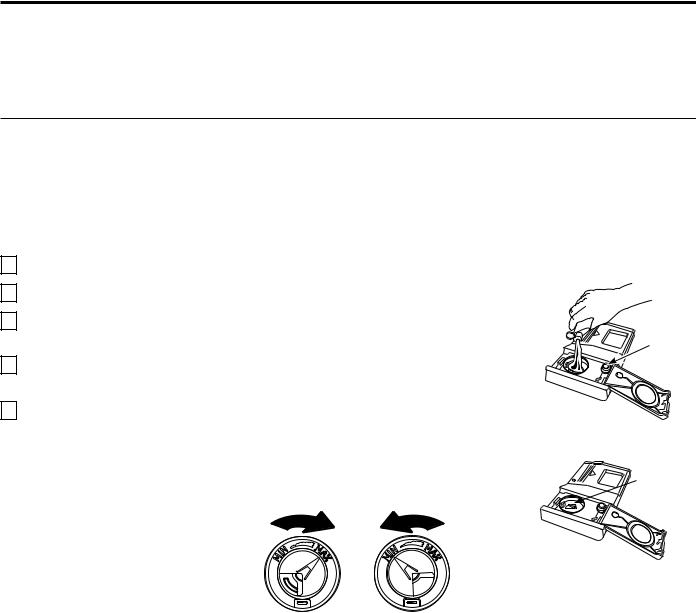
<![endif]>USING THE DISHWASHER
Dispensers
Check the Water Temperature
The entering water should be at least 120°F (49°C) and |
Turn on the hot water faucet nearest the dishwasher, |
not more than 150°F (66°C) for effective cleaning and to |
place the thermometer in a glass and let the water run |
prevent dish damage. Check the water temperature with a |
continuously into the glass until the temperature stops |
candy or meat thermometer. |
rising. |
Use a Rinse Agent
Rinse agents, such as Finish® Jet-Dry® Rinse Aid are designed for great drying action and to protect against spots and film build-up on your dishes, glasses, flatware, cookware, and plastic.
Filling the Rinse Agent Dispenser
The rinse agent dispenser holds 3.5 oz. (104 ml) of rinse agent. Under normal conditions, this will last approximately one month.
1 |
Make sure the dishwasher door is fully open. |
|
2 |
Open the rinse agent dispenser door. |
|
3 |
Slowly add rinse agent until the cup is full. You may need to pause several times to |
|
|
allow rinse aid to settle. NOTE: Indicator window does not light up. |
Indicator |
|
|
|
4 |
Clean up any spilled rinse agent with a damp cloth to prevent foam from forming |
window |
|
||
|
inside the dishwasher. |
|
5 Close the rinse agent dispenser door.
Rinse Aid Setting
The amount of rinse agent released into the final wash can be adjusted. If water drops or |
|
|
hard water spots remain on dishes after the dry cycle, increase the setting. |
Rinse |
|
To adjust the setting |
|
agent |
|
adjuster |
|
Open the Rinse Agent dispenser door; |
|
|
then turn the adjuster clockwise to |
|
|
increase the amount of rinse agent, |
|
|
counterclockwise to reduce the amount |
|
|
of rinse agent. |
|
|
Clockwise to reduce |
Counterclockwise |
|
water drops and |
to reduce foaming |
|
hard water spots |
|
|
10 |
49-4000214 Rev 1 |
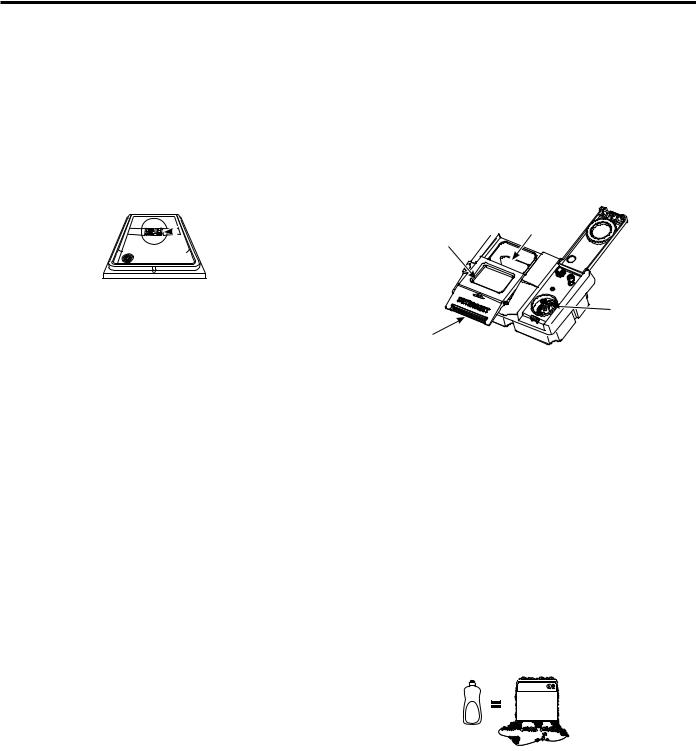
Dispensers
Detergent Dispenser
The detergent dispenser is located in the center of the dishwasher door. It has two compartments. The main wash compartment is found inside the detergent
dispenser. To open, press the button on the side of the dispenser. The pre-wash compartment is on the lid of the detergent dispenser. Use the pre-wash compartment only when your water is extremely hard or when you have a heavy soiled load. The pre-wash compartment is not used when tablet or packet detergents are used.
NOTE: Do not block detergent dispenser with large or tall dishware.
If you choose to use detergent in powder, liquid or gel form, the amount of detergent you use will be determined by the hardness of your water, the temperature of your water, and the food soil load inside the dishwasher. Contact your water company to get information about the hardness of the water in your area. Water hardness is measured in grains per gallon. Use this information and the table above to determine the amount of detergent to use. You may purchase a hard water test strip from GE Appliances. Call 877-959-8688 and ask for part number WD01X10295. In Canada, call 800-661-1616.
Detergent
 Dispenser
Dispenser
You may use tablet, packet, powder, liquid or gel automatic dishwasher detergent. Make sure you use only detergents specifically labeled for use in automatic dishwashers. Never use liquid hand dish detergent in an automatic dishwasher. Sudsing and poor wash performance will result with the use of improper detergents.
Detergents should be stored in a dry location and in their original container to prevent loss of effectiveness. Place detergent in the cup just prior to starting the dishwasher and then close the cover. The cover will open during the wash cycle.
Filling the Detergent Dispenser
GE Appliances recommends using detergent in tablet or packet form. Independent testing has shown this form of detergent is very effective in the dishwasher. Finish® Quantum® Powerball® is an example of this type of detergent. However, some single dose detergents
are not designed for shorter cycles. If you experience wash-out issues with these tablets or packets, follow the
LQVWUXFWLRQV EHORZ
Rinsing cycles - DO NOT use detergents. (These cycles are designed for rinsing dishes only, not soil removal.)
Washing cycles less than 60 minutes (not including additional dry or wash options) - Put a tablet or packet into the pre-wash compartment of the detergent cup, or in the bottom of the dishwasher. (These cycles are designed to be shorter which could result in bad detergent wash-out if the detergent is placed in the main wash compartment of the detergent cup. Wash performance will be diminished as a result.)
Washing cycles 60 minutes or longer (not including additional dry or wash options) - Put a tablet or packet into the main wash compartment of the detergent cup and close the detergent cup cover. (These cycles are designed for tougher soils and will likely have more fills/drains than the shorter cycles. If the tablet or packet is placed in the pre-wash compartment or tossed in the bottom of the dishwasher, the detergent will be flushed down the drain in a very short period of time and will thus be wasted. Wash performance will be very poor as a result.)
Main
Pre-Wash  Wash
Wash
Rinse Agent
Push/Slide
to Close
Use the table as a starting point and then adjust the amount of detergent you use. Use just enough to get good wash performance. Using just the right amount of detergent will provide great wash performance without wasting detergent or etching glassware.
Number of |
Detergent Cup(s) to Fill |
|
Grains/Gal. |
||
|
||
Less than 4 |
Fill cup to 1/3 full |
|
4 to 8 |
Fill cup to 2/3 full |
|
8 to 12 |
Fill cup completely full |
|
Greater than 12 |
Fill both main wash cup and |
|
|
pre-wash cup |
Using too much detergent with very soft and/or very hot water may cause a condition called etching on your glassware. Etching is a permanent cloudiness in your glassware. This condition is irreversible. However, using too little detergent will cause poor wash performance.
DO NOT USE HAND DISH DETERGENT
NOTE: Using a detergent that is not specifically designed for dishwashers will cause the dishwasher to fill with suds. During operation, these suds will spill out of the dishwasher vents, covering the kitchen floor and making the floor wet.
Because so many detergent containers look alike, store the dishwasher detergent in a separate space from all other cleaners. Show anyone who may use the dishwasher the correct detergent and where it is stored.
While there will be no lasting damage to the dishwasher, your dishes will not get clean using a dishwashing detergent that is not formulated for automatic dishwashers.
<![endif]>DISHWASHER THE USING
49-4000214 Rev 1 |
11 |

<![endif]>USING THE DISHWASHER
Appliance Communication
WiFi Connect (on some models) (for customers in the United States)
Your dishwasher is GE Appliances WiFi Connect capable. A WiFi communciation card is built into the product allowing it to communicate with your smartphone for remote monitoring, control and notifications.
Please visit www.GEAppliances.com/connect to connect your appliance, learn more about connected appliance features and learn what connected appliance app’s will work with your smartphone.
:L)L &RQQHFWLYLW\ )RU DVVLVWDQFH ZLWK WKH DSSOLDQFH RU the ConnectPlus network connectivity, please call GE Appliances at 800-GE-CARES.
This device complies with Part 15 of the FCC Rules. Operation is subject to the following two conditions:
1.This device may not cause harmful interference, and
2.This device must accept any interference received, including interference that may cause undesired operation. This equipment has been tested and found to comply with the limits for a Class B digital device, pursuant to Part 15 of the FCC Rules. These limits are designed to provide reasonable protection against harmful interference in a residential installation. This equipment generates uses and can radiate radio frequency energy and, if not installed and used in accordance with the instructions, may cause harmful interference to radio communications. However, there is no guarantee that interference will not occur in a particular installation. If this equipment does cause harmful interference to radio or television reception, which can be determined by turning the equipment off and on, the user is encouraged to try to correct the interference by one or more of the following measures:
•Reorient or relocate the receiving antenna.
•Increase the separation between the equipment and receiver.
•Connect the equipment into an outlet on a circuit different from that to which the receiver is connected.
•Consult the dealer or an experienced radio/television technician for help.
Labelling: Changes or modifications to this unit not expressly approved by the manufacturer could void the user’s authority to operate the equipment.
12 |
49-4000214 Rev 1 |
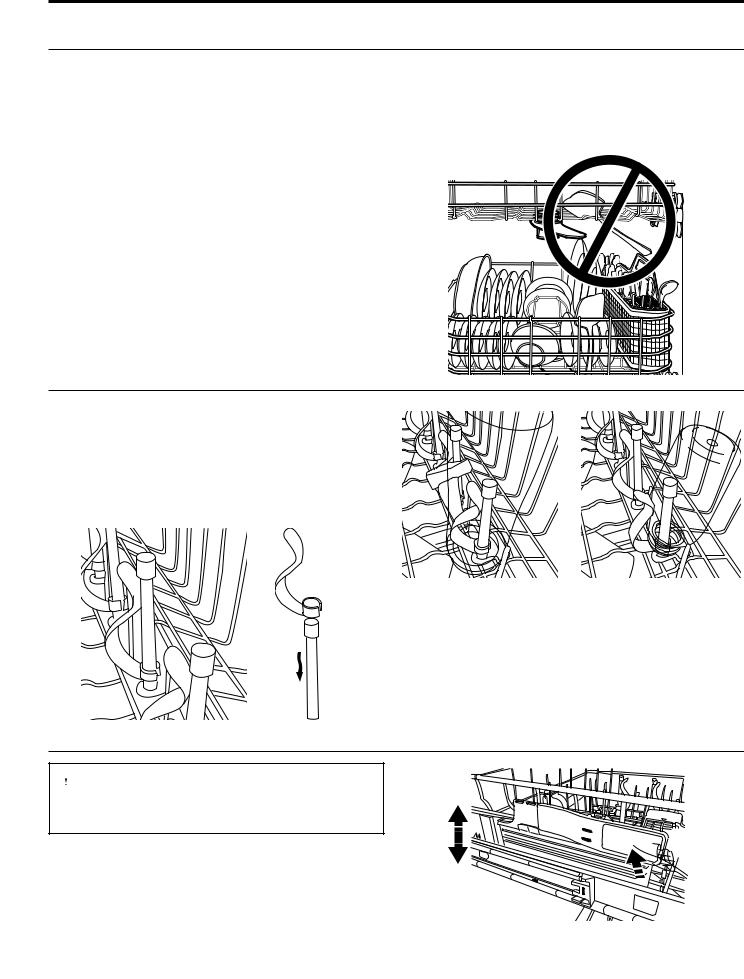
Loading
For best dishwashing results, follow these loading guidelines. Features and appearance of racks and silverware baskets may vary from your model.
Upper Rack
The upper rack is primarily for glasses, cups, and saucers. For best wash performance, tilt cup and glass openings toward the center of the rack. Other items such as pots, pans, and plates may be placed in the upper rack. This is also a secure place for dishwasher-safe plastic items. The upper rack can be used for odd sized utensils. Sauce pans, mixing bowls, and other similarly shaped items should be placed face down for best wash performance. Ensure small plastic items are secure so that they cannot fall on the heater at the bottom of the dishwasher, potentially damaging the item. Some models are equipped with a hidden heater, so dishwasher safe plastic items can be placed in the lower rack.
IMPORTANT: Ensure items in the upper rack do not interfere with the 3rd Rack (on some models) when loading and unloading.
IMPORTANT: Ensure that items do not protrude through the bottom of the rack or silverware basket where they will block the rotation of the middle spray arm. This could result in noise during operation and/or poor wash performance.
The Bottle Jets system (on some models) is the ideal location to position baby bottles, tall sports bottles, or other tall items with narrow openings. The Bottle Jets clips hold bottles with small openings in place so water jets are directed inside the bottles to clean hard to reach areas. Clips can be installed or removed by simply slipping the clip opening over the top of the nozzle.
Clip
Sports bottle held in place |
Baby bottle held in place |
over a Bottle Jets clip |
under a Bottle Jets clip |
Nozzle
Bottle Jets
|
A loaded upper rack may be |
CAUTION |
|
|
heavier than anticipated. To prevent |
|
minor injury or damage to the contents, do not raise or lower the upper rack after the rack is loaded.
The upper rack allows 2” of adjustment up or down to accommodate large items. The upper rack may be lowered by pushing the long flaps on each side of the rack. This will allow you to lower the rack (see fig. Upper Rack). To raise the rack, lift up on the rack until the rack locks in place.
Upper Rack
Pus
<![endif]>DISHWASHER THE USING
49-4000214 Rev 1 |
13 |

<![endif]>USING THE DISHWASHER
Loading
On some models, the upper rack may be adjusted to |
Rail |
|
accommodate larger items. To adjust the upper rack, fully |
End |
|
Hook |
||
extend the upper rack and lift the front of the rack so that |
Upper |
|
the rack roller wheels clear the end hooks on the front of |
||
Rack |
||
the rails. Continue to pull the rack until the remaining rack |
Rail |
|
roller wheels clear the end hook. Select the set of rollers on |
|
|
the side of the rack that provides the desired height, and |
|
|
reinstall the upper rack by aligning the rack roller wheels |
Pull rack out, |
|
on the end hook and rack rails – Ensure that there are |
lift up and over |
|
roller wheels above and below the rack rails. Failure to |
rail end hooks, |
|
and pull out to |
||
properly align the wheels onto the end hook and rails may |
remove |
|
result in the rack falling from the dishwasher. |
Rail |
|
|
End |
|
|
Hook |
|
|
Rack Rollers |
To add flexibility in loading, the stem safe shelf (on some models) may be placed in the up or down position or unfolded and placed in the lower unfolded position.
The shelf may also be used to secure stemware such as wine glasses. Because these stemware items come in various sizes, slowly push the rack in to ensure the items do not bump into the edges of the dishwasher, which may cause damage to the items.
Place the 












 slots in the
slots in the 























 utility shelf
utility shelf 








































 clips over
clips over 















































 the vertical
the vertical 





































































 rack wires
rack wires 







































































 and push
and push 











































































 down to attach
down to attach 






























































 utility shelf
utility shelf 























































 onto second
onto second 










































 wire of rack
wire of rack 



































The fold down tines (on some models) provide flexibility for extra-large and hard-to-fit items. The tine rows can be adjusted to a vertical or lay-down position.
For best dishwashing results, follow these loading guidelines. Features and appearance of racks and silverware baskets may vary from your model.
8 Place Settings - Upper Rack |
10 Place Settings - Upper Rack |
Models - GDF565, GDT565, GDF645, GDP645, GDT645, GDT665, DDT700, PDP715, PDT715, PDT775, PDT785
Models - GDF565, GDT565, GDF645, GDP645, GDT645, GDT665, DDT700, PDP715, PDT715, PDT775, PDT785
14 |
49-4000214 Rev 1 |

Loading
12 Place Settings - Upper Rack
Models - GDF645, GDP645, GDT645, GDF565, |
Models - DDT700, GDT665, PDP715, PDT715 |
GDT565, PDT775 |
|
Models - PDT785
<![endif]>DISHWASHER THE USING
49-4000214 Rev 1 |
15 |
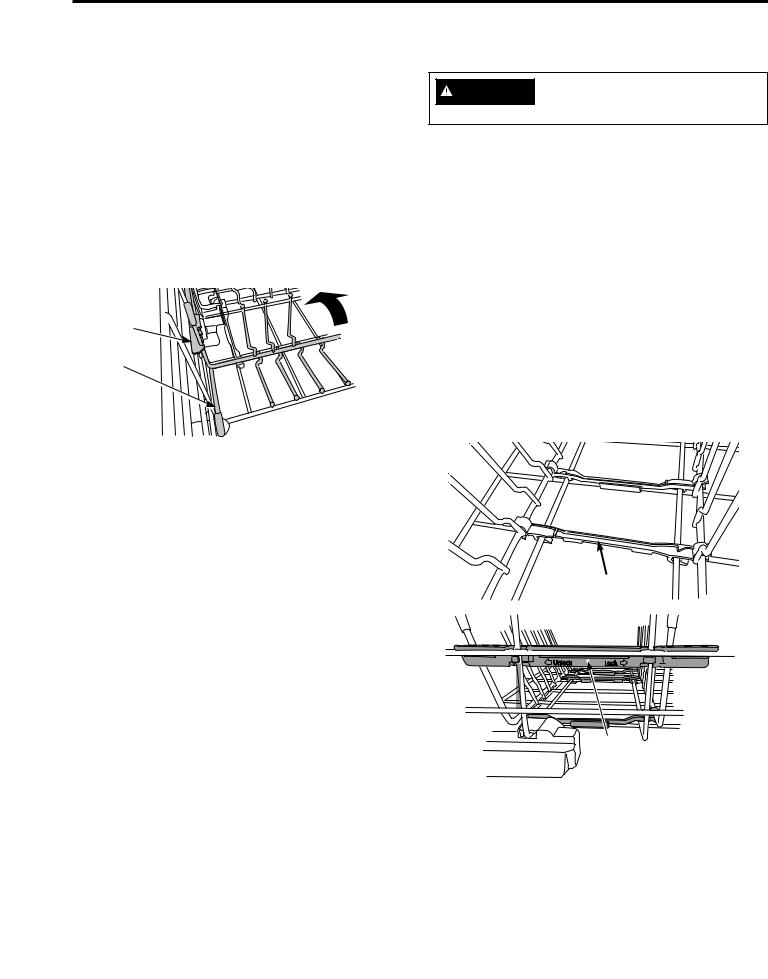
<![endif]>USING THE DISHWASHER
Loading
For best dishwashing results, follow these loading guidelines. Features and appearance of racks and silverware baskets may vary from your model.
Lower Rack
The lower rack is best used for plates, saucers and cookware items. Large items, such as broiler pans and baking racks should be placed along the sides of the rack. If necessary, oversized glasses and mugs can be placed in the lower rack to maximize loading flexibility. Plates, saucers and similar items should be placed between the tines in the direction that allows the item to remain secure in the rack.
NOTE: Do not load large items in the lower rack where they may block the wash jets from rinsing out the detergent dispenser.
The lower rack fold down tines (on some models) can be adjusted to different upright angles or placed flat to provide flexibility for hard-to-fit or extra-large items.
3 Angled Positions Available or Folded Down
The clips can be a choke hazard WARNING for small children if removed from
the dishwasher. Keep out of reach of children.
To change the direction of the fold down tines, lower the tines, then pull away from the bar clips that secure the tines to the rack and remove. Reverse the direction of the tines, orienting the handle on the opposite side of the rack. Reattach the tines to the bar clips by pushing the tines back until they click in place. The indexer will also need to be switched to the opposite side of the dishwasher. To remove the indexer, simply slide it the in the direction labeled “unlock.” Then, align the indexer with the rack on the other side and slide in the direction that says “lock” in order to reattach the indexer to the rack.
IMPORTANT: It is important to ensure that items do not protrude through the bottom of the rack or the silverware basket where they will block the rotation of the lower spray arm. Also, ensure that large plates, pots, or tall items don’t hit the mid spray arm. This could result in noise during operation and/or poor wash performance.
Bar Clip
Indexer
To lock, slide right. To unlock, slide left.
16 |
49-4000214 Rev 1 |
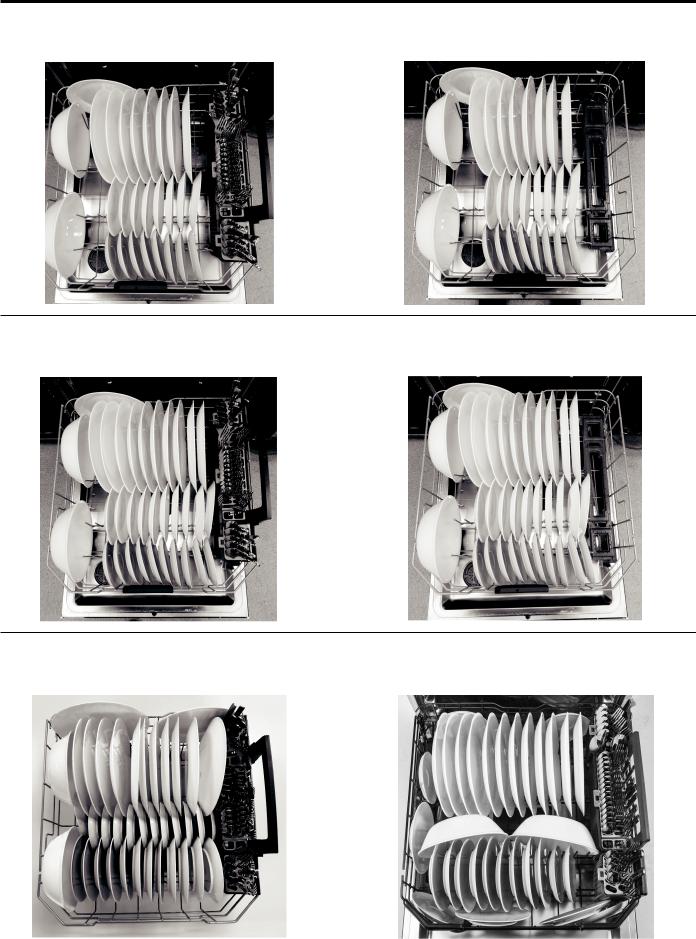
Loading
8 Place Settings - Lower Rack
Models - GDF565, GDT565, GDF645, GDP645, |
Models - DDT700, GDT665, PDP715, PDT715, PDT775, |
GDT645 |
PDT785 |
10 Place Settings - Lower Rack
Models - GDF565, GDT565, GDF645, GDP645, |
Models - DDT700, GDT665, PDP715, PDT715, PDT775, |
GDT645 |
PDT785 |
<![endif]>DISHWASHER THE USING
12 Place Settings - Lower Rack
Models - GDF645, GDP645, GDT645, GDF565, |
Models - DDT700, GDT665, PDT715, PDT785 |
GDT565, PDT775 |
|
49-4000214 Rev 1 |
17 |
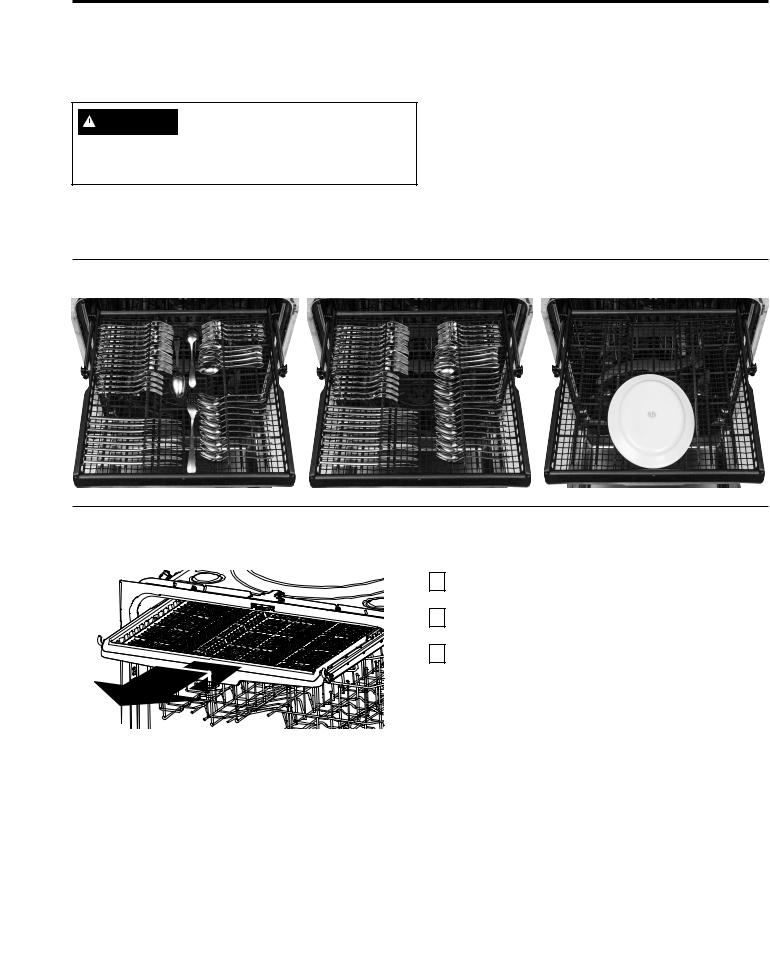
<![endif]>USING THE DISHWASHER
Loading
For best dishwashing results, follow these loading guidelines. Features and appearance of racks and silverware baskets may vary from your model.
3rd Rack (on some models)
The 3rd rack is the recommended location for silverware and large utensils
Take care when loading, unloading,  CAUTION or transporting the silverware or
CAUTION or transporting the silverware or
utensil tray. The tray may contain sharp or heavy items. If items are dropped from the tray or the tray is dropped, injury could occur.
IMPORTANT NOTES:
ŶDo not allow cutlery of different materials to touch each other in the 3rd rack. Doing so may cause discoloration of the cutlery.
ŶThe tray is only meant to be used with a GE Appliances 3rd rack dishwasher to hold silverware, cooking utensils, and other small items. Using the tray for any other purpose could result in damage to the tray or damage to anything interacting with the tray.
ŶEnsure that the 3rd rack is fully closed before shutting the dishwasher door. Shutting the door with the rack partially extended could cause damage to the dishwasher.
8 Place Settings |
10 Place Settings |
12 Place Settings |
7KH UG UDFN LV DOVR UHPRYDEOH WR DOORZ H[WUD ODUJH LWHPV WR EH SODFHG LQ WKH XSSHU UDFN
To remove the 3rd rack:
1 With the rack fully extended, lift the front of the rack so that the rack roller wheels clear the retaining hook.
2 Continue to pull the rack until the remaining rack roller wheels clear the retaining hook.
3 Replace the rack by aligning the rack roller wheels on the retaining hook and rack rails – Ensure all roller wheels are located on top of the rack rails.
18 |
49-4000214 Rev 1 |

Loading
Silverware/flatware is loaded using the silverware basket lids. This ensures great wash performance of the silverware. Loading in this manner prevents nesting and makes sure all items are washed uniformly.
Silverware Basket
Place flatware in the removable silverware baskets. Sharp objects, such as forks and knives, may be placed
with the handles facing up, in order to protect your hands. For the best wash performance, place other items such as spoons with the handles facing down. Avoid allowing items to nest together, which may keep them from being properly washed. When loading, distribute items evenly in the basket.
The silverware baskets may also be used for small items, such as measuring spoons, baby bottle nipples, plastic lids, or corn cob holders. The silverware basket covers can be closed to contain small items.
IMPORTANT: Do not load large or tall utensils where they may block the detergent dispenser, mid spray arm, or
become trapped between the door and the gasket when the door is closed.
Deep Clean Silverware Jets (on some models)
Deep Clean Silverware Jets target stubborn, stuck-on food and help separate nested spoons and forks to keep your silverware spotless no matter how you load the silverware. For optimal silverware cleaning, the use of silverware basket lids is always recommended. For models with the third rack, the Deep Clean Silverware Jets can also be used to clean mixing bowls and other cookware.
Do not remove Deep Clean Silverware Jet spray assembly from the dishwasher rack.
Silverware basket lids
Ensure tabs on back of silverware basket are hooked on top wire of lower rack
Deep Clean
Silverware Jets
<![endif]>DISHWASHER THE USING
Silverware Basket - 8 Place Settings
Models - GDF565, GDT565, GDF645,
GDP645, GDT645
Silverware Basket - 10 Place
Settings Models - GDF565, GDT565,
GDF645, GDP645, GDT645
Silverware Basket - 12 Place
Settings Models - GDF565, GDT565,
GDF645, GDP645, GDT645
Silverware Basket - 8 Place Settings
Models - GDT665, DDT700, PDP715,
PDT715, PDT775, PDT785
NOTE: Refer to the 3rd Rack in this
Loading The Dishwasher section.
Silverware Basket - 10 Place Settings
Models - GDT665, DDT700, PDP715,
PDT715, PDT775, PDT785
NOTE: Refer to the 3rd Rack in this
Loading The Dishwasher section.
Silverware Basket - 12 Place
Settings Models - GDT665,
DDT700, PDP715, PDT715,
PDT775, PDT785
49-4000214 Rev 1 |
19 |

<![endif]>USING THE DISHWASHER
Care and cleaning
Control Panel
To clean the control panel, use a lightly dampened cloth. Then dry thoroughly.
Exterior Door Panel
Before cleaning the front panel, make sure you know what type of panel you have. Refer to the last two letters of your model number. You can locate your model number on the left-hand tub wall just inside the door. If your model number ends with BB, CC, DS, D1, ES, FS, SA, TS, WW or W2 then you have a painted door panel. If your model number ends with SS or S1, then you have a Stainless Steel door panel. If your model number ends with II, then you have an Integrated door panel.
Follow the instructions below for cleaning the door panel for your specific model.
Painted/Coated Door Panel (model numbers ending in BB or D1-black, CC-bisque, DS-black slate, ES-slate, FS-fingerprint resistant, SA-silver, TS-black stainless steel, or WW or W2-white)
Use a clean, soft, lightly dampened cloth, then dry thoroughly.
Stainless Steel Door Panel (model numbers ending in SS or S1)
For cleaning rust and tarnish, cleaners with oxalic acid such as Bar Keepers Friend Soft Cleanser™ will remove rust, tarnish and small blemishes. Use only a liquid cleanser free of grit and rub in the direction of the brush lines with a damp soft sponge. Do not use appliance wax or polish on the stainless steel.
For other blemishes and marks, use Stainless Steel Magic or a similar product using a clean soft cloth. Do not use appliance wax, polish, bleach or products containing chlorine on Stainless Steel. You can order Stainless Steel Magic #WX10X29 through GE Appliances Parts by calling 877.959.8688. In Canada, call 1-800-661-1616.
Integrated Door Panel (model numbers ending in II)
This is a custom installed door panel, and you will need to refer to the cabinet manufacturers recommendations for proper cleaning.
Dishwasher Interior
To clean and de-odorize your dishwasher, use citric acid or Finish® Dishwasher Cleaner, a detergent additive. Finish® Dishwasher Cleaner will break up mineral deposits, and remove hard water film and stains. You can order citric acid GE Appliances kit #WD35X151 through GE Appliances Parts by calling 877-959-8688 or visiting GEApplianceparts.com. In Canada, call 1-800-661-1616. You can purchase Finish® Dishwasher Cleaner at your local grocery store.
Stainless Steel Inner Door and Tub
The stainless steel used to make the dishwasher tub and inner door provides the highest reliability available in a GE Appliances dishwasher.
If the dishwasher tub or inner door should be scratched or dented during normal use, they will not rust or corrode. These surface blemishes will not affect their function or durability.
20 |
49-4000214 Rev 1 |
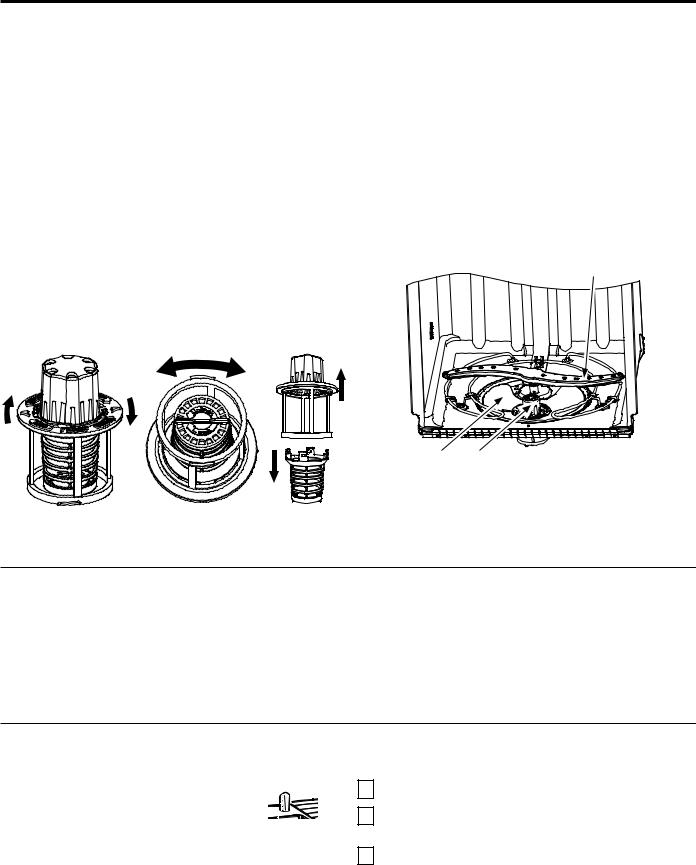
Care and Cleaning
Filters
Inspect and clean the filters periodically. This should be done every other month or more depending on usage. If there is a decrease in wash performance or dishes feel gritty, this is also an indication the filters need to be cleaned.
Ultra-Fine Filter Assembly
To clean the Ultra-Fine Filter assembly, remove the bottom rack. Twist the Ultra-Fine Filter assembly counterclockwise and lift to remove for cleaning. Rinse filter with warm soapy water and use a sponge to carefully remove any stubborn particles.
For models with a 2-piece Ultra-Fine Filter assembly with an additional Filter Basket for food particles, twist the Filter Basket in the counterclockwise direction to unlock it from the Ultra-Fine Filter assembly. See directional arrows on the bottom of the Filter Basket. Pull the Filter Basket to remove from the assembly, throw away any food particles, rinse with warm soapy water, and use a sponge to remove any stubborn particles.
2-piece - Ultra-fine Filter assembly with additional Filter Basket (on some models)
Fine Filter
To clean the Fine Filter (mesh plate), remove the bottom rack. Remove the Ultra-Fine Filter.
Lift the Fine Filter up and out from under the two rear retaining tabs. Rinse filter with warm soapy water. Scouring pads or brushes can scratch the filter surface but a soft brush or sponge may be needed to remove stubborn soils or calcium deposits caused by hard water. Once cleaned, replace the Fine Filter making sure it goes under the two rear retaining tabs. Replace the Ultra-Fine Filter.
Spray
Arm
<![endif]>DISHWASHER THE USING
Fine Ultra-Fine
Filter Filter
Once cleaned, replace Filter Basket back into the Ultra-Fine Filter assembly and twist it clockwise to lock
into place.
Protect Against Freezing
If your dishwasher is left in an unheated place during the
ZLQWHU DVN D VHUYLFH WHFKQLFLDQ WR
|
Turn off electrical power to the dishwasher. Remove |
|
1 |
3 |
|
|
fuses or trip circuit breaker. |
|
|
Turn off the water supply and disconnect the water inlet |
|
2 |
4 |
|
|
line from the water valve. |
|
Drain water from the water inlet line and water valve. (Use a pan to catch the water.)
Reconnect the water inlet line to the water valve.
Does Your Dishwasher Have an Air Gap?
An air gap protects your dishwasher against water backing up into it if a drain clogs. The air gap is not a part of the dishwasher. It is not covered by your warranty. Not all plumbing codes require air gaps, so you may not have one.
Air gap
Check the air gap any time your dishwasher isn’t draining well.
The air gap is easy to clean.
1 Turn off the dishwasher and lift off the air gap cover.
2 Remove the plastic cap under the cover and clean with a toothpick.
3 Replace the cap and cover when the air gap is clean.
49-4000214 Rev 1 |
21 |

<![endif]>TROUBLESHOOTING TIPS
22
Troubleshooting Tips... Before you call for service
Problem |
Possible Cause |
What To Do |
Start status indicator |
The door was opened or the |
Press the Start pad once and close the door within 4 |
light flashing |
cycle was interrupted. |
seconds to start the dishwasher. Press the Start pad a |
|
|
second time when the dishwasher is running only if you |
|
|
wish to cancel the cycle. |
Dishwasher BEEPS |
This is a reminder that your |
Press Start and close the door. |
once every minute |
dishwasher door has been left |
|
|
open during operation. It will |
|
|
continue beeping until you |
|
|
press Start and close the door. |
|
Beeping at the end |
This is normal. Dishwasher |
To turn off the double beep indicator (or re-activate it if |
of the cycle (on |
will beep twice at the end of |
it was previously turned off), press the Dry Boost pad 5 |
some models) |
the cycle. |
times within 3 seconds. A triple beep will sound to indicate |
|
|
the end-of-cycle beep option has been turned on or off. |
Dishes and flatware |
Ultra-Fine Filter or Fine |
See the Care and Cleaning section. |
not clean |
Filter is clogged |
|
|
Low inlet water temperature |
Make sure inlet water temperature is correct (see the |
|
|
USING THE DISHWASHER section). Turn on the hot |
|
|
water faucet nearest the dishwasher, let run until the water |
|
|
temperature stops rising. Then start the dishwasher and |
|
|
turn off the faucet. This ensures the entering water is hot. |
|
|
Select Boost if available. |
|
Water pressure is |
Turn on a faucet. Is water coming out more slowly than usual? |
|
temporarily low |
If so, wait until pressure is normal before using your dishwasher. |
|
|
Normal water pressure to the dishwasher should be 20-120 psi. |
|
Air gap or disposer clogged |
Clean the air gap or flush the disposer. |
|
High drain loop or air gap |
Refer to the Installation Instructions for proper drain line |
|
not installed |
installation. |
|
Improper rack loading |
Make sure large dishware does not block the detergent |
|
|
dispenser or the wash arms. See the Loading section. |
|
Poor performing detergent |
Use a highly rated detergent such as Finish® Quantum® |
|
|
Automatic Dishwashing Detergent. |
Spots and filming |
Extremely hard water |
Use rinse agents such as Finish® Jet-Dry® Rinse Aid to |
on glasses and |
|
prevent spots and prevent new film build-up. |
flatware |
|
If water is extremely hard, a softener may be required. |
|
Low inlet water temperature |
Make sure water temperature is at least 120°F (49°C). |
|
Overloading or improper |
Load dishwasher as shown in the Loading section. |
|
loading of the dishwasher |
|
|
Old or damp powder |
Make sure detergent is fresh. Use a highly rated |
|
detergent |
detergent such as Finish® Quantum® Automatic |
|
|
Dishwashing Detergent. |
|
Rinse agent dispenser empty |
Refill with rinse agent such as Finish® Jet-Dry® Rinse Aid. |
|
Too little or low performing |
Make sure you use the proper amount of highly rated |
|
detergent |
detergent. |
Cloudiness on |
Combination of soft water |
This is called etching and is permanent. To prevent this |
glassware |
and too much detergent |
from happening, use less detergent if you have soft water. |
|
|
Wash glassware in the shortest cycle that will get it clean. |
|
Low performing phosphate- |
See A white film on glassware, dishware and the |
|
free detergent |
interior in this TROUBLESHOOTING section. |
|
Water temperature entering |
This could be etching. Lower the water heater |
|
the dishwasher exceeds 150°F |
temperature. |
Slight odor coming |
This is normal when the Dry |
No action is required. |
from unit during dry |
Boost option is used for the |
|
portion of cycle |
first time. It is caused by the |
|
|
heating of new parts and will |
|
|
disappear in a short time. |
|
|
|
49-4000214 Rev 1 |

Troubleshooting Tips... Before you call for service
Problem |
Possible Cause |
What To Do |
|
Suds in the tub |
Wrong detergent |
Use only automatic dishwasher detergents to avoid sudsing. |
|
|
|
Finish® Quantum® Automatic Dishwashing Detergent |
|
|
|
has been approved for use in all GE Appliances |
|
|
|
dishwashers. |
|
|
|
To remove suds from the tub, open the dishwasher and |
|
|
|
let suds dissipate. Open the door, press and hold Start |
|
|
|
for 3 seconds, and close the door. |
|
|
Rinse agent was spilled |
Always wipe up rinse agent spills immediately. |
|
Detergent left in |
Dishes or utensils are |
Reposition the dishes, so the water from the lower spray |
|
dispenser cups |
blocking the detergent cup |
arm can flush the detergent cup. See the Loading section. |
|
|
|
Reposition the tall utensils or heavy silverware that may |
|
|
|
be keeping the dispenser cup door from opening. See |
|
|
|
the Loading section. |
|
|
|
Don’t place large bowls or pots directly under the |
|
|
|
detergent dispenser. |
|
Black or gray marks |
Aluminum utensils have |
Remove marks with a mild, abrasive cleaner. |
|
on dishes |
rubbed against dishes |
|
|
Dishes don’t dry |
Low inlet water temperature |
Make sure inlet water temperature is at least 120°F. |
|
|
|
Select Boost Dry. |
|
|
|
Use Boost option. |
|
|
|
Select a higher cycle, such as Steam-Sani, Presoak- |
|
|
|
Sani, or Sanitize. |
|
|
Rinse agent dispenser is |
Check the rinse agent dispenser and fill as required. |
|
|
empty |
|
|
|
Additional drying time is |
Leave door closed after the Clean light appears to allow |
|
|
needed |
the fan to run an additional 90 minutes. |
|
|
|
Note: If you open the door, this fan extension will be cancelled. |
|
Control panel |
Door may not be completely |
Make sure the door is firmly closed. |
|
responded to inputs |
closed |
|
|
but dishwasher |
|
|
|
Water valve may be turned |
Make sure water valve (usually located under the sink) is |
||
never filled with |
|||
off |
turned on. |
||
water |
|||
Flood float may be stuck |
Remove Ultra-Fine filter and lightly tap the piece under the |
||
|
|||
|
|
ultra fine filter that looks like a salt shaker. Replace the filter. |
|
Stained tub interior |
White film on inside |
GE Appliances recommends Finish® Jet-Dry® Rinse Aid |
|
|
surface— hard water |
to help prevent hard water mineral deposits from forming. |
|
|
minerals |
Run dishwasher with citric acid to remove mineral |
|
|
|
GHSRVLWV &LWULF DFLG 3DUW QXPEHU :' ; FDQ EH |
|
|
|
ordered through GE Appliances Parts. See back cover |
|
|
|
for ordering information. Alternatively, purchase Finish® |
|
|
|
Dishwasher Cleaner and follow the directions on the |
|
|
|
label. |
|
Dishwasher won’t |
Fuse is blown or circuit |
Replace fuse or reset circuit breaker. Remove any other |
|
run |
breaker is tripped |
appliances from the circuit. |
|
|
Power is turned off |
In some installations, the power to the dishwasher is |
|
|
|
provided through a wall switch, often located next to the |
|
|
|
disposer switch. Make sure it is on. |
|
|
Control panel is locked |
Unlock control panel. See the Getting started section. |
|
|
Proper Start sequence was |
See the Using the dishwasher section. |
|
|
not followed |
|
|
Control panel lights |
Time too long between |
Each pad must be touched within 30 seconds of the |
|
go off when you’re |
touching of selected |
others. To relight, touch any pad again or open the door |
|
setting controls |
buttons |
and unlock (top control). |
<![endif]>TIPS TROUBLESHOOTING
49-4000214 Rev 1 |
23 |

<![endif]>TROUBLESHOOTING TIPS
Troubleshooting Tips... Before you call for service
Problem |
Possible Cause |
What To Do |
Water standing in the |
Air gap is clogged |
Clean the air gap. See the Care and Cleaning section. |
bottom of the tub |
|
|
High drain loop or air gap not |
Refer to the Installation Instructions for proper drain line |
|
|
installed |
installation. |
|
|
|
Water won’t pump |
Drain is clogged |
If you have an air gap, clean it. See the Care and Cleaning |
out of the tub |
|
section. |
|
|
If the dishwasher drains into a disposer, run disposer clear. |
|
|
Check to see if your kitchen sink is draining well. If not, you |
|
|
may need a plumber. |
Steam |
This is normal |
Warm, moist air comes through the vent during drying and when |
|
|
water is being pumped out. This is necessary for drying. |
|
|
|
Sanitized or Cycle |
The door was opened and the |
Do not interrupt the cycle by opening the door during the wash |
Sanitized light does |
cycle was interrupted during |
cycle. |
not illuminate at the |
final rinse |
|
end of the cycle |
|
|
The incoming water temperature |
Raise the water heater temperature to between 120°F and |
|
|
was too low |
150°F. |
|
|
|
Noise |
Normal operating sounds: |
These are all normal. No action is required. |
|
Beeping at the end of the cycle |
|
|
(on some models) |
|
|
Detergent cup opening |
|
|
Water entering dishwasher |
|
|
Motor stops and starts at |
|
|
various times during cycle |
|
|
Spray arms start and stop at |
|
|
various times |
|
|
Drain pump sounds during |
|
|
pump out |
|
|
Drain pump starts and stops |
|
|
several times during each drain |
|
|
Rattling dishes when the spray |
Make sure dishes are properly loaded. See the Loading |
|
arm rotates |
section. |
|
|
|
|
Rattling silverware against door |
Tall utensils may be placed in the upper rack to avoid bumping |
|
during wash |
against inner door during wash cycle. |
|
|
|
A white film on |
This problem is likely caused |
To remove the white film, run your dishes through a dishwasher |
glassware, dishware |
by a low quality phosphate-free |
cycle with citric acid. Use a WD35X151 citric acid kit found |
and the interior |
dishwasher detergent |
online. Otherwise, use Finish® Dishwasher Cleaner found at |
|
|
your local grocery store. |
|
|
Pour the citric acid in the detergent cup and close the cover. |
|
|
Place the filmed but otherwise clean glassware and dishware in |
|
|
the dishwasher. Leave silverware and other metal items out of |
|
|
the dishwasher. Turn the dishwasher on and let it run through |
|
|
a complete cycle without detergent. The glassware, dishware, |
|
|
and dishwasher should come out film free. Alternatively, a vinegar |
|
|
rinse may be used. Pour 1 cup of vinegar into dishwasher just |
|
|
after the detergent cup opens and let the dishwasher complete |
|
|
its cycle. |
|
|
This may be repeated several times a year as needed. |
|
|
The use of a rinse agent such as Finish® Jet-Dry® Rinse Aid |
|
|
may help minimize a repeat build up of film. Also, the use of a |
|
|
highly rated detergent such as Finish® Quantum® Automatic |
|
|
Dishwashing Detergent will help prevent film build-up. |
Feel air on your |
This is normal |
Do not interrupt the cycle. No action is required. |
legs when standing |
|
|
in front of the |
|
|
dishwasher in cycle. |
|
|
|
|
|
24 |
49-4000214 Rev 1 |
